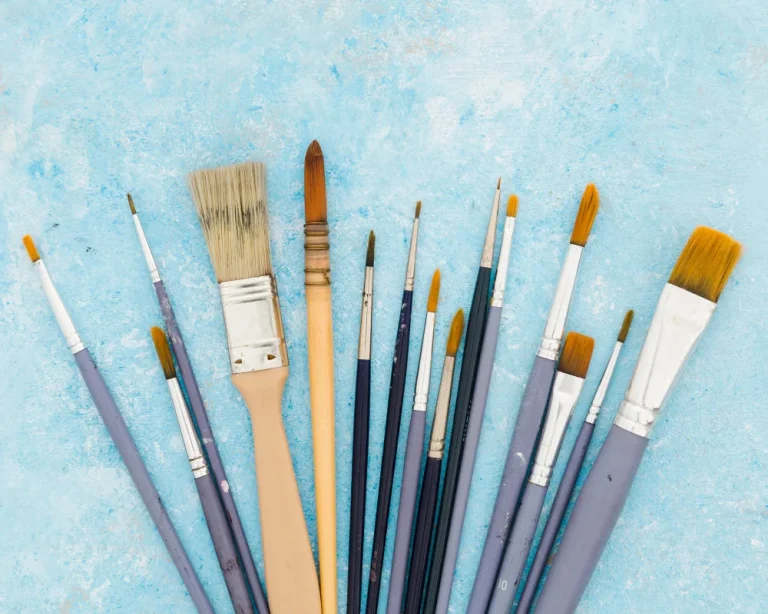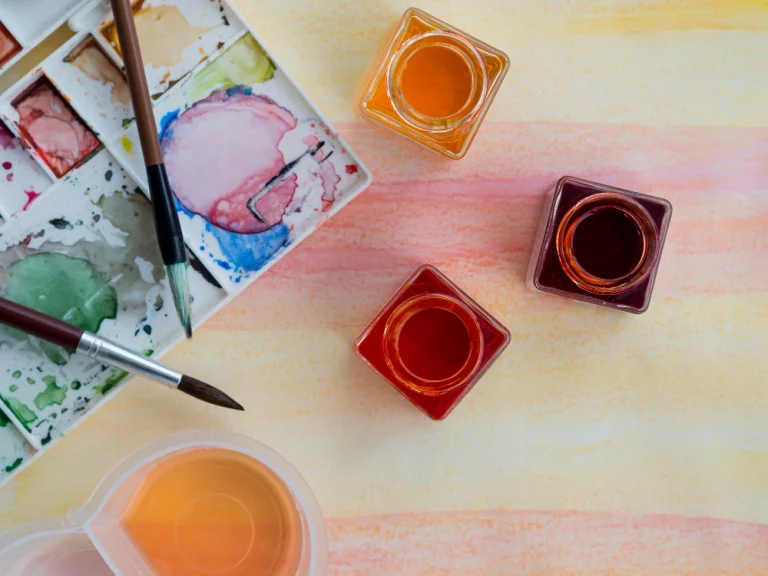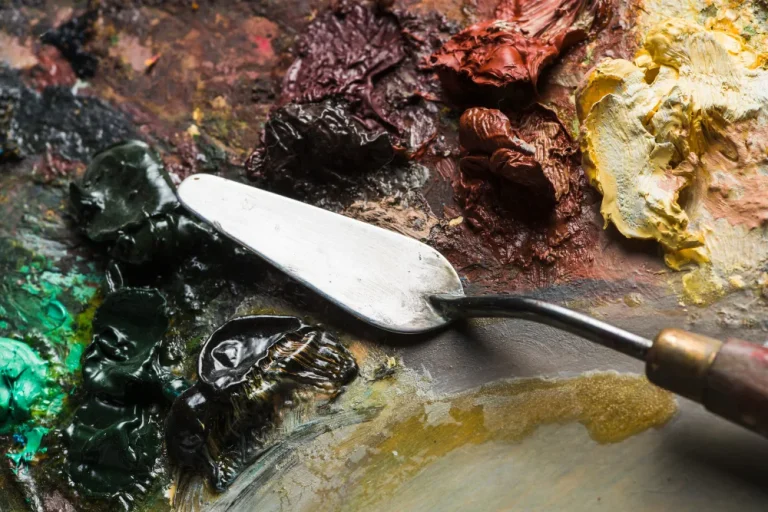
What Is a Body Painting Brush and How Does It Work?
Understanding the Purpose of Different Body Brushes
A body painting brush is a specialized cosmetic tool which paints directly on the skin for cosmetic, theatrical, or artistic purposes. The brushes are designed to fit various paints, including water and alcohol-based products, and provide precision and comfort upon use. The primary functionality of various body brushes is to provide artists with control of coverage, detail, texture, and blurring on human canvas.
Brushes vary not only in size and shape but also in function. Flat brushes are ideal for covering large areas quickly, while round or pointed ones allow for detail in outlining facial contours or detail work. Fan brushes are ideal for feathering or gradient effects on the skin.
Types of Bristles: Synthetic vs Natural
The type of bristle used in a body painting brush significantly impacts its performance. There are three main categories: nylon (synthetic), boar bristle, and natural animal hair.
Brushes are divided into nylon hair, bristle, and natural animal hair. Among them, boar bristle brushes are important products in oil painting. While boar bristles are hard and suited for oil mediums, they are less common in body painting due to their stiffness.
The price of natural animal hair is relatively expensive, but it has very significant and high-quality effects in watercolor painting. These natural hairs offer excellent paint retention and softness but may not be ideal for all skin types or paint types.
Nylon brushes possess nylon hair. Nylon is more elastic, water-absorbent and easy to clean than other materials. It is best suited for acrylic painting and watercolor painting, and the public also loves these two. These factors also make nylon brushes extra beneficial for work in body painting with water-based paints.
Key Features That Affect Performance
Several features affect how well a body painting brush performs:
- Bristle quality: Soft yet elastic bristles ensure smooth application without irritating the skin.
- Ferrule material: High-quality ferrules made from copper or aluminum ensure durability.
- Handle design: Ergonomic handles reduce fatigue during long sessions.
- Paint compatibility: Brushes must hold pigment well without shedding or deforming.
We use more high-quality and delicate nylon and animal hair for master-level brushes, and use copper as a connection to make the overall brush more solid and beautiful.
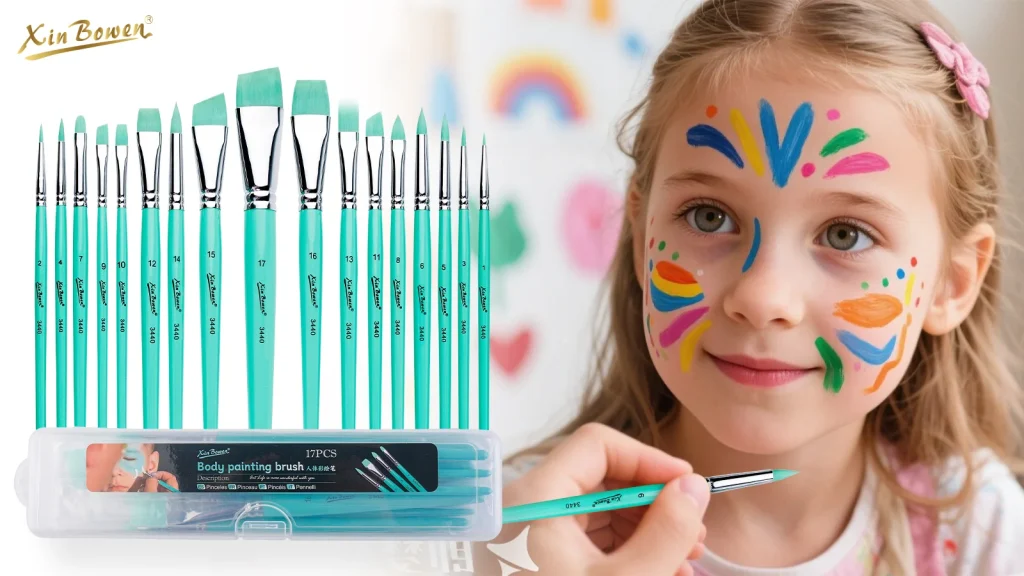
How to Choose the Best Brushes for Body Paint
Factors to Consider When Selecting a Body Painting Brush
Choosing the best brushes for body paint depends on understanding your artistic goals and matching them with brush characteristics.
Brush Size and Shape for Different Applications
Different shapes serve distinct functions:
- Flat brushescover large areas efficiently.
- Round tipsenable fine lines and details.
- Angled brusheshelp with contouring around curves.
- Fan brushescreate gradients or textures like fur or foliage.
Artists should maintain a variety of sizes in their kit to accommodate different techniques.
Compatibility with Water-Based and Alcohol-Based Paints
Some paints require specific brush types. Water-based paints work well with synthetic bristles like nylon due to their absorbency. Alcohol-based paints may require firmer bristles that resist degradation from solvents.
Only high-quality nylon hair that is soft enough but also elastic can be used on brushes because it has good water absorption and paint adhesion.
Recommended Tools: Why Xin Bowen Brushes Are Gaining Popularity
Xin Bowen offers an extensive range of professional-grade brushes tailored to both beginners and masters.
The main advantage of our company in the brush category is high quality, complete variety, various peak shapes, and a large number of stocks. We have made detailed classifications for both master-level and beginner-level brushes, which greatly improves the product recognition and makes it easier for customers to choose.
These classifications aren’t just marketing claims; they follow industry standards by using refined materials like copper ferrules and delicately processed nylon suitable even for face or body art applications.
How Do You Prepare Your Skin for Body Brush Painting?
Cleaning and Moisturizing the Skin Properly
Prior to using any paint with a body painting brush, your skin must be clean. Wash thoroughly with mild soap to remove oils or residue which can prevent adhesion. Next, apply a light moisturizer—oil-free if available—to soften skin and make it pliable without resisting pigment application.
Using Primers or Barriers for Better Paint Adhesion
Professional results generally depend on using primers that are specifically formulated for body art. The primers work to protect your natural oils of the skin from paint layer and seal in color intensity. Sensitive skin or long wear periods (like performances) require an added layer of protection from irritation with a barrier spray.
Avoiding Common Prepping Mistakes
Avoid the use of greasy lotions and sunscreens before painting—these can be streaked or inadequately adhere. Also, steer clear of exfoliating right before use as this can lead to redness or sensitivity under pigment layers.
What Techniques Improve Body Brush Painting Results?
Basic Strokes and Blending Techniques for Beginners
Mastery begins with understanding foundational strokes:
Flat Strokes, Feathering, and Layering
Flat strokes help lay down base colors evenly. Feathering involves light flicks of the wrist to blend edges softly—ideal when transitioning between shades. Layering allows depth by building color intensity gradually without muddying tones underneath.
Creating Texture and Depth with Brushes
Using dry brushing techniques can simulate textures like scales or fabric patterns by dragging lightly loaded bristles across dry skin. Stippling—tapping pigment onto surface—creates dimensional effects such as pores or stubble when done with round-tipped stiff brushes.
Controlling Pressure and Angle for Precision
Varying pressure allows you to control line thickness easily—a light touch gives thin lines; firmer pressure yields bolder strokes. Holding the brush at different angles affects stroke shape; perpendicular angles give sharper lines while tilted angles allow smoother blends.
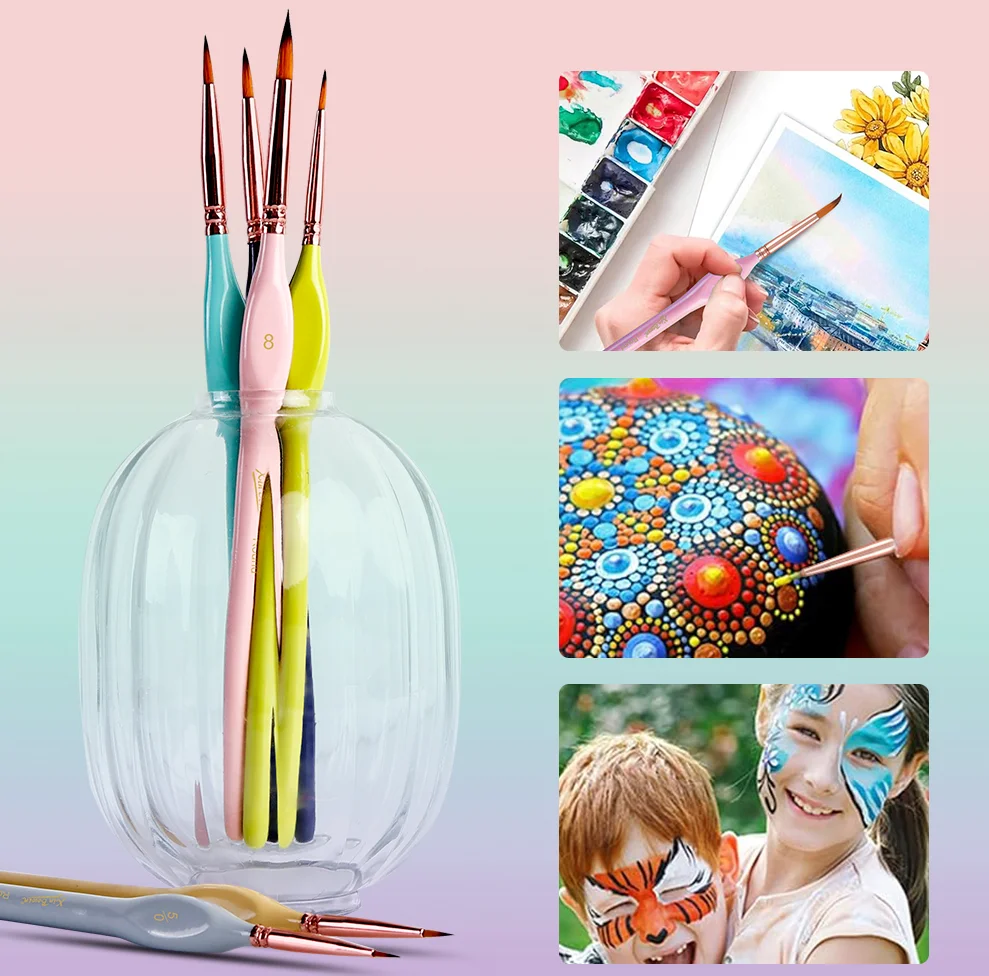
How to Maintain and Clean Your Body Painting Brushes
Proper Cleaning Methods After Each Use
Maintaining your tools ensures longevity:
Water-Based vs Oil-Based Paint Cleaning Techniques
For water-based paints:
- Rinse immediately after use under lukewarm water.
- Use mild soap if needed.
For oil-based paints:
- Clean using appropriate solvents followed by soapy water rinse.
You only need to soak them in warm water to restore the bristles to their original appearance.
Also note:
We use corn glue (an environmentally friendly and non-toxic natural glue that can be easily cleaned) to connect the brushes.
Storage Tips to Extend Brush Lifespan
After cleaning:
- Reshape bristles while damp.
- Store upright with bristles facing upward once dry.
Proper storage can be stored for more than 3 years, ensuring your investment lasts through many projects.
Common Mistakes Beginners Make with Body Brush Painting
Overloading the Brush with Paint
Too much paint causes dripping, uneven application, or blotchy results. Dip only one-third of your brush into pigment at any time.
Ignoring Drying Times Between Layers
Applying new layers before previous ones dry leads to smudging or color mixing unintentionally. Allow full drying before layering highlights or outlines.
Using the Wrong Brush Type for Specific Effects
Each effect requires specific tools—using flat brushes where detail work is needed will reduce sharpness; using soft round tips where texture is desired won’t deliver impact.
FAQ
Q: What brushes are best for body paint?
A: The best brushes include soft yet elastic synthetic options like high-quality nylon that offer great pigment adhesion without irritating skin. Only high-quality nylon hair that is soft enough but also elastic can be used on brushes because it has good water absorption and paint adhesion.
Q: How do you properly use a paint brush?
A: Use appropriate strokes based on area size—flat strokes cover bases; feathering blends edges; stippling adds texture. Control pressure based on desired thickness while keeping angle consistent.
Q: What is the most recommended brushing technique?
A: Layering combined with feather blending offers seamless transitions between colors while maintaining vibrancy—a staple technique among professional body painters seeking realism or fantasy effects.




